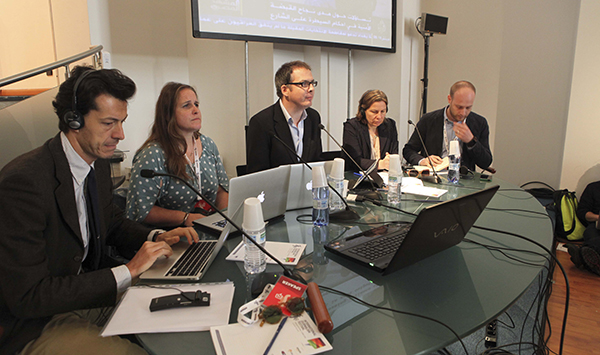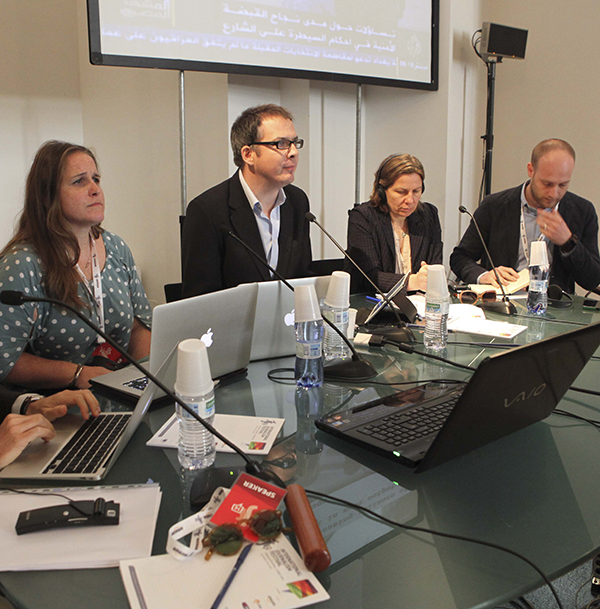 photo by Francesco Bisello Ragno
photo by Francesco Bisello Ragno
The 2011 Egyptian revolution not only changed the course of Egyptian history, but also that of journalism. That is the time that user-generated content (UGC) became essential in covering breaking news, says Fergus Bell, social media editor for the Associated Press.
Ever since, news outlets have increasingly relied on UGC in covering breaking news, particularly when covering foreign stories. This new development in news coverage is the topic of an investigation carried out by Sam Dubberley and Claire Wardle of the Tow Center for Digital Journalism of the Columbia School of Journalism. They monitored eight broadcasts and online channels over a three-week period as well as interviewed journalists to see the modes of use of UGC, a contentious term they defined as “photographs and video captured by people unrelated to the newsroom.” Their findings were presented and discussed with media and law experts in a panel carrying their research’s title, “Amateur Footage: the increasing reliance of user-generated content in news output”.
Verification is worth your time
Wardle and Dubberley observed that UGC was usually unverified or unregulated: “I don’t think people realise the extent to which it is a wild west on social media, it is such a wild west.” This was the feeling shared by the journalists interviewed. One of the main issues, said Wardle, is the lack of awareness on how to verify UGC. Some think “gut instinct” is enough. An editor told them: “People are scared of the ‘V-word.’ They know it’s going to take a long time.” News outlets increasingly rely on agencies as an insurance policy, because they trust their work to have been verified for them.
“It’s not easy for us either” said Bell, but Associated Press is able to program a workflow that allows UGC verification by using all the resources at their disposal. The first step is checking who is the actual owner of the material and starting the verification process from there. Caroline Bannock, coordinator of Guardian Witness, a UGC community embedded with the British paper, uses a different model altogether: the focus is not on content discovery, but on having users sharing content about the story they need. When needing verification, Bannock has one golden rule: “Half of the process is about content, but the most important part is speaking to the user,” she said. Even then, she admitted, an element of doubt always persists: you can maybe reach 99% certainty, but never 100%.
For the law, this is enough. Matteo Jori, lawyer and professor of Information Technology Law at the University of Milan, stressed that in a court of law what matters is that there was a verification process in place. Exception is granted to those ‘neutral’ platforms like YouTube, which do not verify their content as a policy. Bell, however, was clear about AP’s policy regarding unverified content: “An unverified YouTube video is a rumour, and we do not report rumour.”
Accreditation is a legal and moral necessity
Once the uploader and its content are verified, the next practice is accreditation. Wardle said journalists know how to ask for permission, but do not credit as often. If the audience is not aware of who the content producers are and what their agenda is, there is a transparency issue. Jori specified that attribution is a crucial issue, and its presence is not enough: the correct author needs to be identified too. In fact, some platforms may appropriate certain rights, like that of ownership, from the uploader. Reading the small print and knowing the platform in which the content is found, as different websites have different terms and conditions, is always a good idea. As Bell said, it is the media outlets’ responsibility to be transparent about how that content will be used. Not only is attribution a moral and legal necessity, but it also allows for creativity to thrive rather than be stifled.
Prioritise safety and ethics
Ethical usage of the content is also an issue worth considering, said Wardle. When dealing with a dramatic event, news outlets tend to mindlessly ask users to share their content without worrying about safety. Bannock agreed that it is the media outlets’ responsibility to think about it, as non-journalists may not be aware of the risks they may face: Guardian Witness’ users are just as valuable as the content they produce.
In this confusing “brave new world,” as Wardle called it, of UGC and amateur footage, more work is needed in defining best practices favouring all parties involved. New initiatives are developing to face the ethical, legal, and practical challenges emerging. Bell’s suggestion is a stronger cooperation between users and media outlets: ultimately, only that will provide better content.


